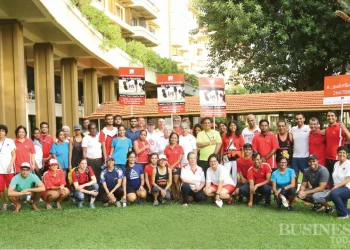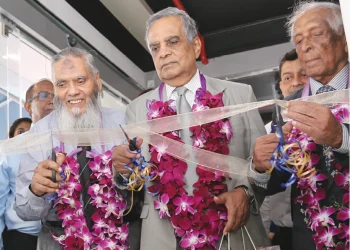
The Sri Lankan shoreline extends over 1,700 kilometres with diverse coastal destinations and beautiful beaches. Since the 1980s, the Department of Coastal Conservation and Coastal Resource Management (CC & CRMD) has been working towards preventing coastal erosion and pollution. As of 2011, legislative provisions towards protecting the coast have been made more stringent. Prabath Chandrakeerthi, Director General of the CC & CRMD speaks about the department’s five-year Coastal Zone Management Plan. He adds that state institutions as well as the public must work together towards ensuring the preservation of the island’s coast for the future.
By Udeshi Amarasinghe and Keshini de Silva
Photography Mahesh Bandara and Menaka Aravinda
What are the main responsibilities of the CC & CRMD?
The Department of Coastal Conservation and Coastal Resource Management was established under the Coastal Conservation Act No 57 of 1981. However, the Department commenced operations in 1983. Previously, Coastal Protection Unit was established in 1963 under the port commission and 1978 Coast Conservation Division was set up under the Ministry of Fisheries with the aim of conserving the coast, creating safe and sustainable development opportunities based on high valued economic resources that exist in the coast. As a result of that coast conservation division was upgraded to an “A Grade development” in January 1984 under the coast conservation Act No 57 of 1981.
Around Sri Lanka there is a coastal belt exceeding 1,700km. One of the main responsibilities of the CC & CRMD is to control the development activities taking place along the coast. The responsibility of issuing permits for all development activities taking place in the coastal zone and managing those development activities under the department. This includes hotel projects, commercial projects and housing projects.
The coastal zone that falls under the purview of the area lying within a limit of 300m landwards of the Mean High Water line and a limit of two kilometres seaward of the Mean Low Water Line. In case of natural water bodies that connect to the sea periodically or permanently, the landward boundary will extend two kilometres measured perpendicular to the straight base line from the natural entrance point. Thereby joining the waters of such water bodies and the area (riparian land) lying within, thus further extending the limits of 100m inland from zero Mean Sea Level along the periphery of these water bodies. We focus on controlling all development activities within this zone. For example, the Colombo Port City development project falls under our purview. As the project approving agency, we review the EIA or IEEs for the large development projects, which are identified as environmental impact assessment before granting the final approval for the project.
One Of The Main Responsibilities Of The CC & CRMD Is To Control The Development Activities Taking Place Along The Coast.
Another responsibility is managing the coast line against coastal erosion due to natural and man-made effects. The south west coast is the most erosive coast; therefore the department still gives priority to control erosion in these coasts. To address the problems, hard solutions and soft solutions are introduced. Together with the Tourism Development Authority, we work towards stablising the infrastructure for the tourism industry. In addition, we also allocate facilities for public recreation by developing beach parks as well as maintaining access roads to the coast.
What are the recent projects by the CC & CRMD?
A foreign funded project named participatory coastal zone restoration and sustainable management in eastern province funded by GEF/IFARD. (Global Environmental Fund & International Funds for Agricultural Development) agencies. Project activities were done under five themes. Ecosystem Restoration, Conservation & Management, Livelihood, Ecotourism Development & Awareness, Climate change adaption & disaster risk reduction and Education & community coordination.
This year, a budget of 1.3 billion rupees has been allocated for the Department. The artificial sand nourishment is the latest project. Creation of beach from Ratmalana to Mount Lavinia and resoration of destructed sand bar at Calido beach, Kalutara are main objectives of the project. The Cabinet has approved the project with a budget allocation of 800 million rupees.
The Act Also Empowers The Director General Of The CC & CRM To Issue Orders For The Removal Of Unauthorised Constructions Without A Court Order.
Presently, Marawila to Chilaw in Puttlam district, is identified as the most erosive coast due to variance of sediment budget and high wave attack. As I mentioned earlier, hard solutions such as revetments, break waters and groyner have been constructed to mitigate the problem. In addition to that, two sand nourishment programs were done as soft solutions.
Meanwhile, COPA has appointed a sub-committee to study the possibility to develop tourism with conserving the coastal resources from Mirissa to Negombo. SLTB, UDA , CEA and Fisheries Department are the main organisations included in this subcommittee. Now the consultancy work has been awarded to a reputed consultanant following the Government procument procedure and we expect to publish the output of the study by end of this year.
Could you tell us about the Colombo Port City?
We have issued the permit after conducting EIA . Previously, EIA addressed only for reclamation area of the projects. Because of that, the project was temporally suspended in 2015. After that supplimentory EIA was done for the entire project including dredging sites surrounding water bodies and marina, and public opinion was sought. An environmental monitoring committee has been established to monitor the mitigation measure identified in the EIA during construction period.
Does the department work with the communities?
At the recent CHOGM in the United Kingdom, which President Maithripala Sirisena attended, the CCD proposed and accepted the responsibility for a mangrove restoration project. We were selected as the Champion of the project.
Together with the community and fisheries associations we replanted 5,000 mangroves in Kalpitiya. Shortly after, during the Commonwealth Secretary General’s visit to Sri Lanka, she toured the project site and appreciated our efforts. In addition, we organised beach clean ups with the community, especially with NGOs, the Navy and the Hoteliers Association.
Can you elaborate on the legal provisions and policies for coastal conservation?
The first Coastal Conservation Act was enacted in 1981. This was later amended in 1988 and 2011. The Coastal Conservation (Amended) Act No 49 of 2011 is a powerful act. According to the legal provisions of the act, the police officer may without order from a Magistrate and without obtaining a warrant, arrest any person reasonably suspected. No bail shall be allowed by a magistrate during the continuance of any proceedings in respect of an offence under this Act.
The Act also empowers the Director General of the CC & CRMD to issue orders for the removal of unauthorised constructions without a court order. This law is more powerful than the UDA Act, which requires a court order for the removal of illegal constructions. Furthermore, there are provisions in the Act to claim the demolition cost from the owners of the illegal constructions, if they do not demolish the structures when the notice is issued. In accordance with this Act, we have removed unauthorised constructions in coastal areas such as Mirissa, which had for several years obstructed the public from using the beaches. We also found that several illegal activities were being carried out in these structures.
There are regulations prepared according to the provision of the Act. Permit fee for the relevant development activity is included in the regulation.In 2018, we created a five-year Coastal Zone Management Plan, which in accordance with the new Act is renewable every five years. It outlines how the Department will work towards protecting the Sri Lankan coastal belt, managing coastal development projects as well as assisting fishery and tourism activities.
In Mirissa, there were complaints that adequate warning was not given before the demolition of unauthorised structures?
That is not the case. Demolition orders had been issued even before I assigned duties in the department. After we held discussions with all those concerned, we notified them that they must vacate the unauthorised constructions and issued special letters. However, they did not believe we would follow through with the demolition orders and some even sought political intervention. As we were not intimidated and because we strongly stood by the decision, we were able to complete the project with the support of the President as well as assistance from the political authorities in the district. Subsequently, we held discussions with those concerned, and held workshops and are now in the process of assisting them in meeting the criteria to obtain authorisation to build legal structures.
The ‘No Build Zone’ Is Public Property. No One Can Seize Ownership Of These Beaches And People Cannot Be Restricted From Entering The Beaches.
Greater awareness about coastal conservation emerged after the 2004 Tsunami. Are there any other awareness programmes to educate the public?
We conduct awareness programme in conjunction with development projects. In 2015, when we re-created the Unawatuna beach, we removed all unauthorised constructions and worked together with the hoteliers. After demarcating the zones within which the hotels can operate, we initiated replanting programmes, which were conducted by the hotels. Even during the Kalpitiya mangrove replanting campaign, we conducted awareness programmes for the communities.
General awareness programmes are held for the public, especially at schools. In lieu of World Environment Day, we organise various school level competitions such as art contests for public awareness. We are in the process of introducing Coastal Conservation as a special topic in the school curricula and teachers are currently receiving the necessary training.
Could you explain the setback area or No Build Zone?
The setback area was introduced in the Coastal Zone Management plan in 1990. A coastal setback is a geographical strip or band within the coastal zone or within, which certain development activities are prohibited or significantly restricted. Coastal set back varies according to the criterias mentioned in the CZM relevant to the coastal segments. Coastal setback varies from 35m to 125m for the coastal zone. After the Tsunami in 2004, the Government introduced 100m and 200m uniform coastal setback for the coastal zone. However, as Sri Lanka is a country with a small landmass, this would have significantly obstructed development initiatives. As a result, for certain areas that are of tourism importance we have reduced the setback, based on criteria imposed by CZMP. It is calculated, based on international regulations concerning disasters, conservation of the coast, fishing activities and tourism.
The 1,700 kilometre coastal belt has been divided into 105 segments. One such segment is Usswetakeiyawa to Mount Lavinia Hotel, where the minimum setback or ‘No Build Zone’ is 20 metres inland from the permanent vegetation line. From the Dikkowita Fishery Harbour north boundary to Galle Face Hotel, the setback is 20-50 metres; from the Galle Face Hotel to the Wellawatte Railway Bridge the No Build Zone is 10-35 metres; from the bridge to the Mount Lavinia Hotel, the setback maintained is 15 metres; from Mount Lavinia Hotel to the Panadura river mouth the setback is 15 metres. In Hikkaduwa, Mirissa, Unwatuna and Polhena at times we have reduced the setback to ten metres. Towards the North-East of the island the setback increases. The maximum set back is 125 metres, allocated to the segment from Pulmudai Arisimalai Point to the Kokkilai lagoon; the minimum setback for this segment is 45 metres.
The ‘No Build Zone’ is public property. No one can seize ownership of these beaches and people cannot be restricted from entering the beaches. Similar to the coastal zone, the area two kilometres inwards from the river deltas or mouths and 100 metres on either side also falls under the purview of the CCD. To create awareness on these regulations, we advertise in the media and I, myself have spoken about these rules on various television programmes.
There are assumptions that the CC & CRMD does not support development.
We always support development activities in the coastal zone. In accordance with the Act, we perform Environmental Impact Assessments (EIA) and Initial Environment Examinations (IEE). If an EIA is conducted, then public comments are required, however, public opinion is not sought for an IEE. The Director General has the power to decide on the assessment to be done based on the stipulations of the Act. Our intention is not to pose an obstacle to developers, however, we must protect our environment and as a result we follow the guidelines of the Coastal Conservation Act before issuing the permits. We do not discourage new developments, and we offer our fullest support to both Sri Lankan and foreign investment projects.
What are the challenges the CC & CRMD faces and how are they being overcome?
Our main concept focuses on a ‘Green Coastal Belt’, which is the basis for mangrove and coconut palm replanting projects. The main challenge we face is erosion, because sand flows to the coast via rivers; 103 main rivers connect to the Sri Lankan coastal belt. When the sand flow from the rivers to the sea reduces, the sea in turn takes its quota of sand from the coast. Therefore, sand mining along river banks has a detrimental affect on the coast. We require sand for construction, however, in order to conserve the environment, alternatives will need to be sought. The rising of the oceans as a result of melting ice caps has also significantly contributed to coastal erosion.
“I Request Everyone To Avoid Discarding Waste, Especially Plastic And Polythene, To The Rivers… Our Aim And Responsibility Is To Protect The Island’s Beautiful Beaches For Future Generations.”
Moreover, the waste and garbage discarded into the 103 rivers flow to the sea causing pollution. For example, recently chemicals dumped in India emerged on our coast. United Nations data indicates that beach pollution occurs mainly as a result of waste dumped by those residing inland flowing along the rivers to the beaches as opposed to the waste dumped by those residing near the beaches. This is the reason why 90 per cent of the beaches are polluted. At present, we have identified that there are over 1,500 unauthorised structures across the island’s coast. We are in the process of demolishing these and hope that it will contribute to a reduction in pollution. We encounter many obstacles when removing these structures, and it is in such a demanding environment that we operate in.
We constantly measure the water quality at the coast. Due to the waste from the rivers, the quality of the sea water is at a poor state. The CC & CRMD is currently working with other institutions including the Central Environmental Authority to create awareness amongst those residing inland. We are also working with the Marine Environment Protection Authority (MEPA).
Is this the first time a Coastal Zone Management Plan has been formulated?
No. There are three CZM plans that had been implemented in 1990,1997 and 2004. But after the ammendement of the act in 2011, the new CZM plan was drafted and gazetted this year after taking the cabinet approval.
It has been addressed to the shoreline management coastal resource and coastal zone management, the coastal pollution and management of SMA (Special Management Area). As a part of initiative of the environment day, this year, we achieved the goal, declaring the Panama sand dune as the affected area under the provision of the act.
Could you tell us about yourself?
It has been three years since I was appointed as Director General of the CC & CRMD. I am an attorney at law by profession. I have been employed in the Sri Lanka Administrative Services for 18 years. His Excellency President Maithripala Sirisena is also our Minister and with the support of the President and Secretary of the Ministry we continue our work as my best.
Message to the public?
I request everyone to avoid discarding waste, especially plastic and polythene, to the rivers. In addition, I warn everyone against building illegal structures along coastal areas, as those who flout the Coastal Conservation Act will face severe repercussions. Always seek permission and permits from the CC & CRMD. Our aim and responsibility is to protect the island’s beautiful beaches for future generations. Tourists are attracted to Sri Lanka because of the lovely coastline. The CC & CRMD alone cannot conserve the coast, we require the support and assistance of other institutions and especially the public.






